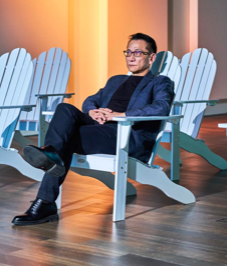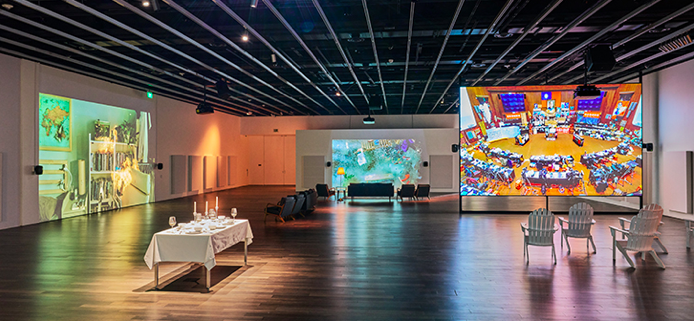Resist & Persist
Everyday War
Yuan Goang-Ming
Asian Art Museum
Ongoing –July 7
At the outset, I warn you that I have pulled together a number of disparate threads in order to provide context for this exhibition. The fact that multiple issues are discussed is a tribute to the breadth and reach of Yuan Going-Ming’s installation, that was over ten years in the making. Hang with me, Dear Reader, as I try to provide you with well-rounded picture of the questions raised in Yuan Goang-Ming’s world famous exhibition that has finally reached this hemisphere.
FAME IN THE US
Before achieving widespread fame at home, Clint Eastwood often boasted about the international popularity of his films in Europe, particularly his “spaghetti westerns” which were especially popular in Italy and Spain. Thus, he gained recognition and acclaim, before his American audience fully embraced his work.
For artists, fame in the US often develops slowly, arriving on little cat feet and sitting on silent haunches before it finally blooms (or moves on). Thanks, Sandburg 🐾
Such is the case for Yuan Goang-Ming, the Taiwanese video artist and photographer known throughout the Asia-Pacific, and whose work was also THE show to see at the 60th Venice Biennale, last year. If you skipped Venice last year, curator Abby Chen, of the San Francisco Asian Art Museum is your new BFF. Chen curated Yuan’s Venice Biennale exhibition last year. As a result of their relationship, she was able to insure that the debut exhibition of the “Father of Taiwanese Video Art” in this country (indeed, this hemisphere) would be in our own backyard. So, skate on over to the Asian Art Museum; it will be well worth the trip.
ADIRONDACK CHAIR
The original Adirondack chair was created in 1903 by Thomas Lee, who wanted the “perfect outdoor chair” for his lake house at Lake Champlain, NY. More than 30 years ago, Sunset magazine published the DIY plans for the Adirondack chair. In consistently featuring and celebrating the chair, given the magazine’s focus, this attention further solidified its popularity and its association with outdoor relaxation.
On April 8, 1951 (or some say 7 – that International Dateline can be tricky), a group of at least 13 men sat around on comfy Adirondack chairs in the Marianas Islands in the South Pacific, six years after the end of WWII. It was an overcast day and yet all the men appear to be wearing some heavy-duty sunglasses, while seemingly casually waiting with their legs crossed …watching. Then it happens. Somewhere 15-30 miles away, a flash of light. The US Air Force has just exploded another in a series of aboveground nuclear bomb tests, this one 81-kilotons strong. In total, the US exploded nine aboveground nuclear bombs (if you don’t count Hiroshima and Nagasaki).
This test was simply another in that series. Nothing special. Well, the Bikini Atoll was decimated and remains radioactive to this day. On the other hand, we did get those cute swimsuits out of the experiment. What made the April 8th nuclear detonation unique was that there was a photographer present to document the officials in the audience that day, lounging in Adirondack chairs.
Personally, I find it inexplicable and bizarre that the USAF transported a bunch of Adirondack chairs to the Marianas Islands so that the bigwigs would be comfortable while observing the awesome power that can wipe out humankind. I’m not alone. Yuan finds the use of the chair, at best, unfathomable, or at its worst, a weapon of war.
As you move through this exhibition, pay attention to the number of times Yuan injects an Adirondack chair into the individual displays. What is he trying to say? The Adirondack chair is easily recognized as a uniquely American item of furniture. Taiwan is a unique nation, created and continuing to exist by relying on American military might. Power that we live with, here in this country, casually, comfortably, even as we sit in our garden chairs. The Taiwanese live with this extension of American power with great disquietude. Yes, Taiwan flourishes but it is also exists as a thorn in the side of the People’s Republic of China. Sometimes the saber-rattling is so loud we can hear it on this side of the Pacific.
Can you imagine how loud is sounds in Taipei? Yuan can. He lets us hear it as a cacophony of militaristic warnings play through the exhibition.
Top to Bottom:
USAF photo prior to explosion.
Yuan’s pencil drawing, What Lies Beyond Us? The exhibition’s quietest artwork provides a key to one of its most important themes.
Actual photo from the nuclear explosion test.
Yuan’s pencil drawing, in context, with an Adirondack chair in place.
POLITICS BY GEOGRAPHY
Tim Marshall in his brilliant and eminently readable book, Prisoners of Geography describes what it’s like to live in China, Russia, Germany, etc. where your country is surrounded by flat plains. Vast tracts of maneuverable land crying out to invading hordes, making you the target of invasion. Geographical factors tending to make the inhabitants edgy.
China tried to overcome the problem with the Great Wall, until 8.24.2023, when a construction excavator made the 2,244 year old wall look like Legos run over by a skateboard.
So, China clings tighter to Tibet. It may be a plateau but at least it’s surrounded by the Himalayas, and no excavator is making its way through that!
If you’ve ever tried to buy a house, you know that the realtor will be eager to first show you the “perfect” house for you. Truth is, that the house is often perfect; it’s also usually just out of your price range (but that it a story for another day). According to Marshall, if you were shopping for a country, the first country the realtor would show you is the good, ol’ USofA. A hemisphere virtually all to yourself. (Thanks, James Monroe) Friendly-ish neighbors to the north and south. Oceans on either side, making invasion quite tricky (although the indigenous populations no doubt see this whole thing differently). So, Americans have been nestled in a security blanket almost from the country’s inception. We don’t suffer what I’d call “invasion anxiety” like other populations.
Being surrounded by an ocean, an island-nation, might sound like you have found the best solution. After all, for millennia it has been extremely difficult, although not impossible, to invade what is now the UK. Still, not all island-nations are created equal. Imagine you are a citizen of Taiwan. Sensing any invasion-anxiety now? If so, you’re getting an idea of how Yuan Goang-Ming feels. He’s put that feeling into his videos and brought us Everyday War, his exhibition at the Asian Art Museum.
Yuan installation at Asian Art Museum
ARTIST: Yuan Goang-Ming
Yuan’s intense commitment to video art has made him one of the pioneering new media artists in Taiwan since the 1990s. His works range from single-channel videos, computerized interactive installations, installation-based video projections, to prints created with digital media.
City Disqualified
His patience, persistence and attention to detail are unrivaled. Approximately 20 years ago, he created the photograph City Disqualified. It was a large-scale photograph of the busiest street corner in Taiwan, but there were absolutely no people. How could anyone take this photo in the middle of the day without people? Turns out, Yuan took hundreds of photos from the same position, then selected the parts of each photo that had no people, layered them and collapsed them into a single image. The resulting photograph took an enormous amount of very detailed, patient work. That is one of the hallmarks of all of Yuan’s art: It is precise and patient, with an astounding attention to detail you don’t often see, especially in installation art. It’s more like the work of a painter who is concerned with every brushstroke.
Everyday War
This solo exhibition is Yuan Goang-Ming’s rallying cry to resist and persist. Just the message we need in these turbulent times. It encompasses the artist’s work from 2014 to the present, including Everyday Maneuver and The 561st Hour of Occupation, along with Everyday War.
Top to Bottom:
Empty streets of Taipei during a Wanan Air Raid Drill. Notice the Adirondack chairs set for viewing in the bottom picture.
Everyday Maneuver depicts the hauntingly empty streets of Taipei, discordant from the typically bustling metropolis, while air raid sirens blare through the air. It documents the Wanan Air Raid Drills, which are held annually for the last 47 years. From July 22 – 25, the Taiwanese hold a 30-minute drill where air raid sirens sound, and all the people on the island are instructed to shelter in place, as a practice in preparation for an invasion from mainland China.
Taiwan’s Legislative Chamber with posters and graffiti
The 561st Hour of Occupation, on the other hand, is full and lively. He depicts the Sunflower Student Movement, where students occupied, postered and graffitied the Legislative Yuan [Taiwan’s legislative chamber] during 24 days in March – April 2014. The camera slowly pans through the hall, passing through time and space as the cheering and waving students begin to fade, leaving the posters alone in the chamber, which the students had occupied for 585 hours. A slowed-down version of the Taiwanese National Anthem accompanies the visuals.
These videos lead one to the Everyday War installation, where Yuan set off a bomb inside his living room and catalogued the destruction from such an event.
Yuan’s Living Room after the bomb
Thus, when viewed together, the videos demand answers to both the personal and the collective’s ever-longing inquiry into the meaning of home in an era when conflict and fragility are the norm: What is survival? What is living? Peace? Safety? Freedom? Where does the art intersect with the pain?













